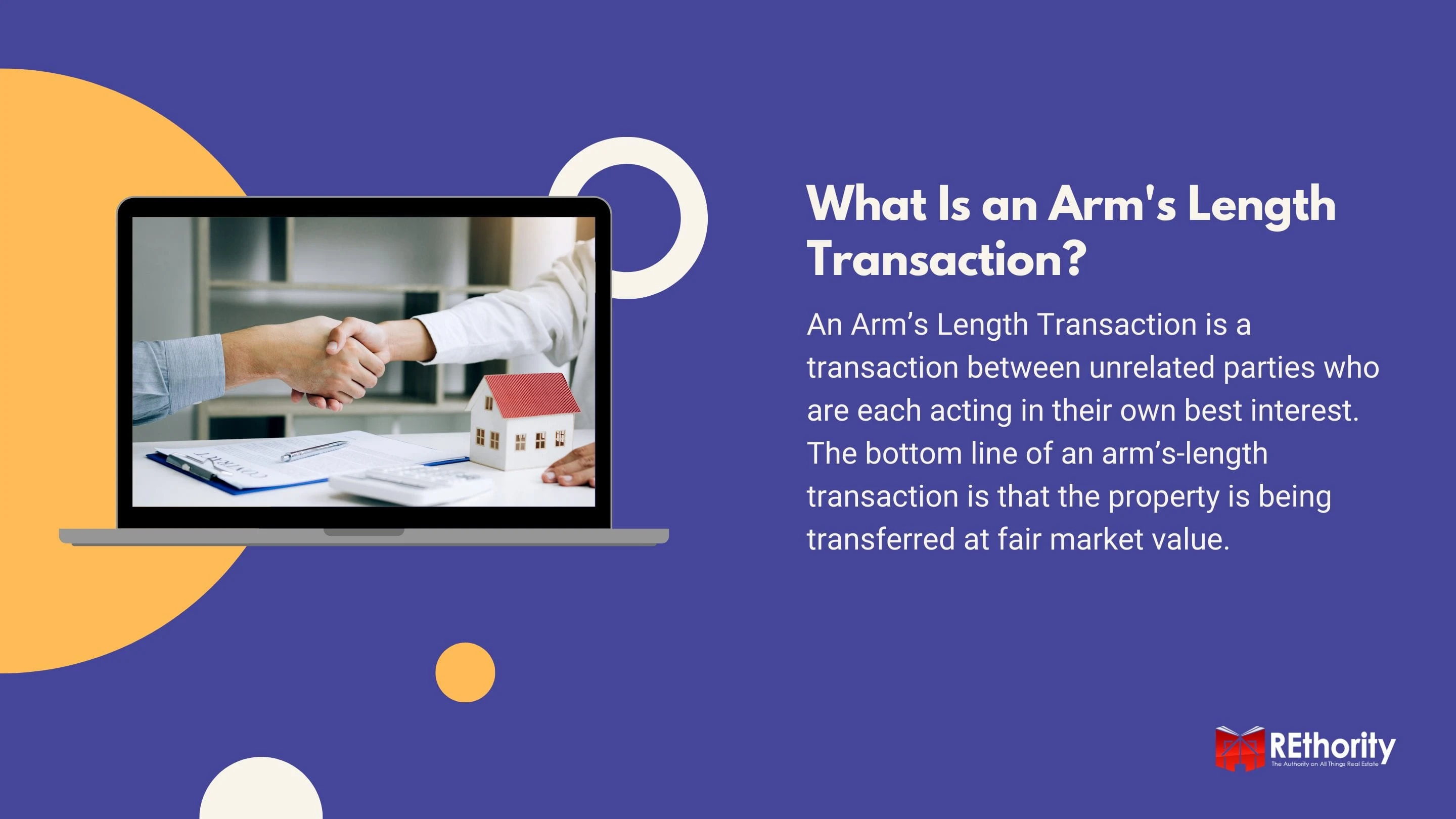In some cases, lenders won’t finance a deal unless it is an arm’s length transaction. When it comes to tax consequences, a non-arm’s length seller may wind up with an unexpected tax bill.
Any real estate agent or other real estate professional needs to understand the arm’s length principle.
They need to know why it’s important. And they should know how to reassure lenders and taxing authorities that a real estate transaction is done at arm’s length.
What Is an Arm’s Length Transaction?
An Arm’s Length Transaction is a transaction between unrelated parties who are each acting in their own best interest.
The definition of an arm’s length transaction will be laid out in the affidavit you’ll be presented with at closing. The details may vary according to the lender or taxing authority.

It’s important to understand that an arm’s length transaction is not illegal. Some lenders require that some transactions only be arm’s length deals.
But don’t worry, you can still do a deal with both family members and business partners without breaking any laws. Generally, there are three aspects of an arm’s length transaction:
- The parties to the deal—generally the buyer and seller—have no pre-existing relationship. In essence, they don’t have any family or professional ties.
- They each have equal bargaining power. Neither has the ability to coerce the other on the terms of the deal.
- The parties are acting in their own self-interest. That is, the buyer is trying to get the highest price. The seller is trying to get the lowest price.
For an example of an official definition, the Federal Housing Administration (FHA) has this description:
The flip side of an arms’ length deal is an arm-in-arm transaction. That is, it’s a deal where the parties are somehow related and may be colluding in their joint interests.
The bottom line of an arm’s-length transaction is that the property is being transferred at fair market value. Doing the deal at true value is the objective of these tests and the arm’s length transaction affidavit.
What’s Not an Arm’s Length Transaction?

Sirtravelot/Shutterstock
There is no definition of an arm’s length transaction that everybody agrees with. However, it’s one of those things that almost everybody can recognize when they see it without being able to define it.
However, there are some parties that will be assumed to be doing an arm-in-arm transaction. For instance, if the sale is between:
- Family members such as siblings, parents and offspring
- Partners in a partnership
- Businesses and members of the owners’ families
- Managers and their family members
- Companies and related shareholders
- Trusts, trustees or beneficiaries
- Employers and employees
- A legal guardian and the guardian’s ward
- Parent companies and subsidiaries
Beyond this list, arm’s length concerns may arise if one side of the deal has enough control over the other to influence their actions.
Another factor that would cause concern is if the parties are close enough to work together to manipulate the price or hide a crucial fact.
Why Arm’s Length Transactions Are Important

If it’s not breaking the law to do an arm-in-arm deal, why is it a problem? There are two main parties that care:
- Lenders
- Tax authorities
Foreclosure
The lenders worry that related parties to a transaction may inflate the price. A buyer may buy a property from a related seller for more than it’s worth, financing it with a loan.
Then the buyer may let the property go into foreclosure. The bank is stuck with collateral worth less than the loan. The seller, meanwhile, may split the proceeds of the inflated sale with the buyer.
Short Sales
Lenders are especially alert to arm-in-arm transactions on pre-foreclosure short sales. These are sales when a property in default is being purchased for less than the owner owes on the mortgage.
In a pre-foreclosure short sale, the lender accepts the sale price to settle the debt, even though it’s less than the loan balance.
The fear is that if the buyer and seller are related, the buyer will later transfer title back to the seller. This would defraud the lender.
Inflated Pricing
Lenders can also get stung by arm-in-arm transactions that don’t involve a relationship between the buyer and seller. If the seller and the appraiser have a relationship, for instance, the appraisal may be artificially inflated.
That could cause the buyer to overpay and the lender to overfund the deal. In a case like this, a flipper may buy a property and do some inexpensive cosmetic improvements.
A related appraiser may produce an inflated appraisal, indicating the flipper underwent major renovations.
As a result, the buyer pays too much, and the lender’s collateral is worth much less than the loan. Property tax agencies, sales tax collectors, and income tax authorities are also concerned.
Reduced Taxes
They worry that parties to a non-arm’s length transaction will artificially deflate the price. That will typically reduce the taxes owed on the sale. For example, say a mother sells a rental house to her daughter.
The mother sells the property below its market value to help her daughter. In this case, taxing authorities might apply a fair market value estimate to the deal.
They will charge the mother income taxes on what would have been her gain if the property sold at fair value.
How to Avoid Problems

Rawpixel.com/Shutterstock
Given lender and tax authority worries, it’s important to be able to show that a deal is at arm’s length. The two main ways to show that a deal is an arm’s length transaction are:
- Have an independent appraisal showing the sale price is fair market value
- Sign an affidavit stating there is no collusion and everyone is equal and acting in their own interest
These are just general rules. If you’re concerned about how tax laws might affect a transaction, consult a tax professional. If you aren’t sure a deal will violate a lender’s terms, check with the lender or with an attorney.
Financial entities may have their own rules about what constitutes an arm’s length transaction. Some won’t do deals that break their rules. For instance:
- Banks generally prohibit short sales between related parties
- Federal National Mortgage Association (FNMA) also requires an arm’s length affidavit on short sales
- FHA won’t fund short sales between related parties. For other non-arm’s length deals, FHA may require parties to have 15 percent equity
- Veteran’s Affairs (VA) won’t fund construction loans that convert to permanent mortgages if related parties are involved
Penalties for Breaking the Rules
Arm’s length transactions aren’t illegal by themselves. But if the parties assert they aren’t related and it turns out the sale is fraudulent, penalties can be severe.
The Federal Bureau of Investigation is responsible for investigating mortgage fraud. If convicted, fraudsters face up to 30 years in jail and fines of up to $1 million, plus restitution.
For an honest real estate professional, knowing a deal is at arm’s length makes it easier to get financed.
For buyers and sellers, it can affect taxes. Either way, it’s important to know what it means when you hear the term “arm’s length transaction.”

